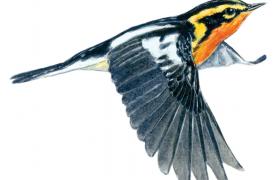Body
- In the fall, blue jays gather acorns and hide them away to snack on throughout winter. By stuffing its flexible throat and carrying one in its beak, a jay can haul up to eight acorns at a time.
- The tri-colored bat is one of the smallest bats found in North America. This flying fluffball measures only 3 inches from nose to tail and weighs about as much as a quarter.
- When an American white pelican wishes for fishes, it gets some buddies to help catch them. The pelicans paddle together, herding fish into the shallows. There, the birds scoop them up with their great big beaks.
- Oh, snap! In the fall, witch hazel fruits dry up and pop open. This causes an audible SNAP! as shiny black seeds shoot out and zing up to 30 feet away from the parent plant.
- Camouflaged loopers eat a rainbow of different flowers. To stay disguised while it dines, the crafty caterpillar plucks petals from whatever it’s munching and sticks them to its back with silk.
- As a fish grows, the scales on its body get bigger, too. In some fish, scales develop a pattern of rings or lines for each year of growth. You can count these — like growth rings on a tree — to learn the fish’s age.
- The web of a triangle weaver spider works like the pulled-back string of a bow. When bugs land, the arachnid archer lets go of an anchor thread, and the stretched-out strands of silk slingshot the spider toward its prey.
Also In This Issue
Media

Body
If icy weather, frozen toes, and snotsicles hanging from your nose make you think twice about winter duck hunting, give September’s teal season a try.
Media

Body
Wild critters face cold weather in many different ways.
And More...
This Issue's Staff
Bonnie Chasteen
Les Fortenberry
Angie Daly Morfeld
Noppadol Paothong
Marci Porter
Mark Raithel
Laura Scheuler
Matt Seek
David Stonner
Stephanie Thurber
Cliff White
Les Fortenberry
Angie Daly Morfeld
Noppadol Paothong
Marci Porter
Mark Raithel
Laura Scheuler
Matt Seek
David Stonner
Stephanie Thurber
Cliff White






















